Linux platform 设备驱动实验-基于正点原子IMX6ULL开发板
我们以前的设备驱动都非常的简单,都是对IO进行最简单的读写操作。像I2C、 SPI、LCD 这些复杂外设的驱动就不能这么去写了,Linux 系统要考虑到驱动的可重用性,因此提出了驱动的分离与分层这样的软件思路,在这个思路下诞生了我们将来最常打交道的platform 设备驱动,也叫做平台设备驱动。现在我们就来学习一下 Linux 下的驱动分离与分层,以及 platform 框架下的设备驱动该如何编写。
1 Linux 驱动的分离与分层
1.1 驱动的分隔与分离
对于 Linux 这样一个成熟、庞大、复杂的操作系统,代码的重用性非常重要,否则的话就会在 Linux 内核中存在大量无意义的重复代码。尤其是驱动程序,因为驱动程序占用了 Linux内核代码量的大头,如果不对驱动程序加以管理,任由重复的代码肆意增加,那么用不了多久Linux 内核的文件数量就庞大到无法接受的地步。
假如现在有三个平台 A、B 和 C,这三个平台(这里的平台说的是 SOC)上都有 MPU6050 这 个 I2C 接口的六轴传感器,按照我们写裸机 I2C 驱动的时候的思路,每个平台都有一个MPU6050的驱动,因此编写出来的最简单的驱动框架如图所示:
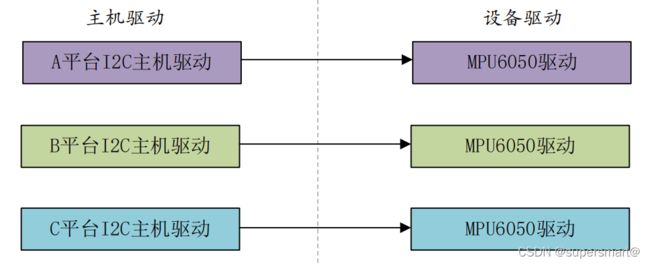
从上图 可以看出,每种平台下都有一个主机驱动和设备驱动,主机驱动肯定是必须要的,毕竟不同的平台其 I2C 控制器不同。但是右侧的设备驱动就没必要每个平台都写一个,因为不管对于那个 SOC 来说,MPU6050 都是一样,通过 I2C 接口读写数据就行了,只需要一个 MPU6050 的驱动程序即可。如果再来几个 I2C 设备,比如 AT24C02、FT5206(电容触摸屏)等,如果按照上图中的写法,那么设备端的驱动将会重复的编写好几次。显然在 Linux 驱动程序中这种写法是不推荐的,最好的做法就是每个平台的 I2C 控制器都提供一个统一的接口(也叫做主机驱动),每个设备的话也只提供一个驱动程序(设备驱动),每个设备通过统一的 I2C接口驱动来访问,这样就可以大大简化驱动文件,上图中三种平台下的 MPU6050 驱动框架就可以简化为下图所示:

实际的 I2C 驱动设备肯定有很多种,不止 MPU6050 这一个,那么实际的驱动架构如下图所示:
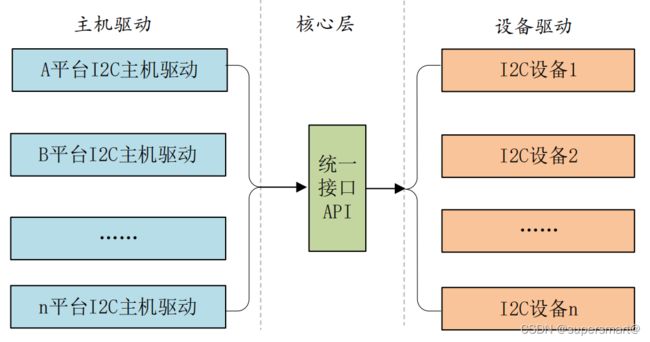
这个就是驱动的分隔,也就是将主机驱动和设备驱动分隔开来,比如 I2C、SPI 等等都会采用驱动分隔的方式来简化驱动的开发。在实际的驱动开发中,一般 I2C 主机控制器驱动已经由半导体厂家编写好了,而设备驱动一般也由设备器件的厂家编写好了,我们只需要提供设备信息即可,比如 I2C 设备的话提供设备连接到了哪个 I2C 接口上,I2C 的速度是多少等等。相当于将设备信息从设备驱动中剥离开来,驱动使用标准方法去获取到设备信息(比如从设备树中获取到设备信息),然后根据获取到的设备信息来初始化设备。 这样就相当于驱动只负责驱动,设备只负责设备,想办法将两者进行匹配即可。这个就是 Linux 中的总线(bus)、驱动(driver)和设备(device)模型,也就是常说的驱动分离。总线就是驱动和设备信息的月老,负责给两者牵线搭桥,如图所示:
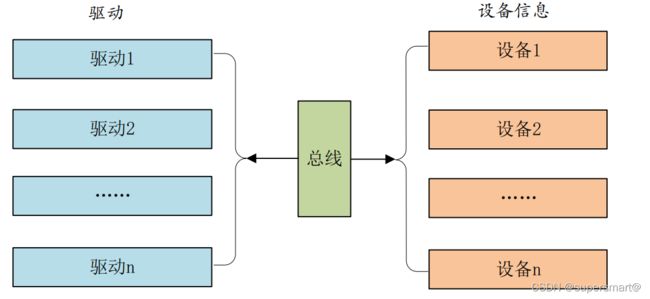
当我们向系统注册一个驱动的时候,总线就会在右侧的设备中查找,看看有没有与之匹配的设备,如果有的话就将两者联系起来。同样的,当向系统中注册一个设备的时候,总线就会在左侧的驱动中查找看有没有与之匹配的设备,有的话也联系起来。Linux 内核中大量的驱动程序都采用总线、驱动和设备模式,我们一会要重点讲解的 platform 驱动就是这一思想下的产物。
1.2 驱动的分层
上一小节讲了驱动的分隔与分离,本节我们来简单看一下驱动的分层,大家应该听说过网络的 7 层模型,不同的层负责不同的内容。同样的,Linux 下的驱动往往也是分层的,分层的目的也是为了在不同的层处理不同的内容。以其他书籍或者资料常常使用到的input(输入子系统)为例,简单介绍一下驱动的分层。input 子系统负责管理所有跟输入有关的驱动,包括键盘、鼠标、触摸等,最底层的就是设备原始驱动,负责获取输入设备的原始值,获取到的输入事件上报给 input 核心层。input 核心层会处理各种 IO 模型,并且提供 file_operations 操作集合。我们在编写输入设备驱动的时候只需要处理好输入事件的上报即可,至于如何处理这些上报的输入事件那是上层去考虑的,我们不用管。可以看出借助分层模型可以极大的简化我们的驱动编写,对于驱动编写来说非常的友好。
2 platform 平台驱动模型简介
前面我们讲了设备驱动的分离,并且引出了总线(bus)、驱动(driver)和设备(device)模型,比如 I2C、SPI、USB 等总线。但是在 SOC 中有些外设是没有总线这个概念的,但是又要使用总线、驱动和设备模型该怎么办呢?为了解决此问题,Linux 提出了 platform 这个虚拟总线,相应的就有 platform_driver 和 platform_device。
2.1 platform 总线
Linux系统内核使用bus_type结构体表示总线,此结构体定义在文件include/linux/device.h,bus_type 结构体内容如下:
1 struct bus_type { 2 const char *name; /* 总线名字 */
3 const char *dev_name;
4 struct device *dev_root; 5 struct device_attribute *dev_attrs; 6 const struct attribute_group **bus_groups; /* 总线属性 */
7 const struct attribute_group **dev_groups; /* 设备属性 */
8 const struct attribute_group **drv_groups; /* 驱动属性 */
9
10 int (*match)(struct device *dev, struct device_driver *drv);
11 int (*uevent)(struct device *dev, struct kobj_uevent_env *env);
12 int (*probe)(struct device *dev);
13 int (*remove)(struct device *dev);
14 void (*shutdown)(struct device *dev);
15
16 int (*online)(struct device *dev);
17 int (*offline)(struct device *dev);
18 int (*suspend)(struct device *dev, pm_message_t state);
19 int (*resume)(struct device *dev);
20 const struct dev_pm_ops *pm;
21 const struct iommu_ops *iommu_ops;
22 struct subsys_private *p;
23 struct lock_class_key lock_key;
24 };
第 10 行,match 函数,此函数很重要,单词 match 的意思就是“匹配、相配”,因此此函数就是完成设备和驱动之间匹配的,总线就是使用 match 函数来根据注册的设备来查找对应的驱动,或者根据注册的驱动来查找相应的设备,因此每一条总线都必须实现此函数。match 函数有两个参数:dev 和 drv,这两个参数分别为 device 和 device_driver 类型,也就是设备和驱动。platform 总线是 bus_type 的一个具体实例,定义在文件 drivers/base/platform.c,platform 总线定义如下:
1 struct bus_type platform_bus_type = {
2 .name = "platform",
3 .dev_groups = platform_dev_groups,
4 .match = platform_match,
5 .uevent = platform_uevent,
6 .pm = &platform_dev_pm_ops,
7 };
platform_bus_type 就是 platform 平台总线,其中 platform_match 就是匹配函数。我们来看一下驱动和设备是如何匹配的,platform_match 函数定义在文件 drivers/base/platform.c 中,函数内容如下所示:
1 static int platform_match(struct device *dev,
struct device_driver *drv)
2 {
3 struct platform_device *pdev = to_platform_device(dev);
4 struct platform_driver *pdrv = to_platform_driver(drv);
5
6 /*When driver_override is set,only bind to the matching driver*/
7 if (pdev->driver_override) 8 return !strcmp(pdev->driver_override, drv->name);
9
10 /* Attempt an OF style match first */
11 if (of_driver_match_device(dev, drv))
12 return 1;
13
14 /* Then try ACPI style match */
15 if (acpi_driver_match_device(dev, drv))
16 return 1;
17
18 /* Then try to match against the id table */
19 if (pdrv->id_table)
20 return platform_match_id(pdrv->id_table, pdev) != NULL;
21
22 /* fall-back to driver name match */
23 return (strcmp(pdev->name, drv->name) == 0);
24 }
驱动和设备的匹配有四种方法,我们依次来看一下:
第 11~12 行,第一种匹配方式, OF 类型的匹配,也就是设备树采用的匹配方式,of_driver_match_device 函数定义在文件 include/linux/of_device.h 中。device_driver 结构体(表示设备驱动)中有个名为of_match_table的成员变量,此成员变量保存着驱动的compatible匹配表,设备树中的每个设备节点的 compatible 属性会和 of_match_table 表中的所有成员比较,查看是否有相同的条目,如果有的话就表示设备和此驱动匹配,设备和驱动匹配成功以后 probe 函数就会执行。
第 15~16 行,第二种匹配方式,ACPI 匹配方式。
第 19~20 行,第三种匹配方式,id_table 匹配,每个 platform_driver 结构体有一个 id_table成员变量,顾名思义,保存了很多 id 信息。这些 id 信息存放着这个 platformd 驱动所支持的驱动类型。
第 23 行,第四种匹配方式,如果第三种匹配方式的 id_table 不存在的话就直接比较驱动和设备的 name 字段,看看是不是相等,如果相等的话就匹配成功。
对于支持设备树的 Linux 版本号,一般设备驱动为了兼容性都支持设备树和无设备树两种匹配方式。也就是第一种匹配方式一般都会存在,第三种和第四种只要存在一种就可以,一般用的最多的还是第四种,也就是直接比较驱动和设备的 name 字段,毕竟这种方式最简单了。
2.2 platform 驱动
platform_driver 结 构 体 表 示 platform 驱动,此结构体定义在文件include/linux/platform_device.h 中,内容如下:
1 struct platform_driver {
2 int (*probe)(struct platform_device *);
3 int (*remove)(struct platform_device *);
4 void (*shutdown)(struct platform_device *);
5 int (*suspend)(struct platform_device *, pm_message_t state);
6 int (*resume)(struct platform_device *);
7 struct device_driver driver;
8 const struct platform_device_id *id_table;
9 bool prevent_deferred_probe;
10 };
第 2 行,probe 函数,当驱动与设备匹配成功以后 probe 函数就会执行,非常重要的函数!!一般驱动的提供者会编写,如果自己要编写一个全新的驱动,那么 probe 就需要自行实现。
第 7 行,driver 成员,为 device_driver 结构体变量,Linux 内核里面大量使用到了面向对象的思维,device_driver 相当于基类,提供了最基础的驱动框架。plaform_driver 继承了这个基类,然后在此基础上又添加了一些特有的成员变量。
第 8 行,id_table 表,也就是我们上一小节讲解 platform 总线匹配驱动和设备的时候采用的
第三种方法,id_table 是个表(也就是数组),每个元素的类型为 platform_device_id,
platform_device_id 结构体内容如下:
1 struct platform_device_id {
2 char name[PLATFORM_NAME_SIZE];
3 kernel_ulong_t driver_data;
4 };
device_driver 结构体定义在 include/linux/device.h,device_driver 结构体内容如下:
1 struct device_driver {
2 const char *name;
3 struct bus_type *bus;
4
5 struct module *owner;
6 const char *mod_name; /* used for built-in modules */
7
8 bool suppress_bind_attrs; /* disables bind/unbind via sysfs */
9
10 const struct of_device_id *of_match_table;
11 const struct acpi_device_id *acpi_match_table;
12
13 int (*probe) (struct device *dev);
14 int (*remove) (struct device *dev);
15 void (*shutdown) (struct device *dev);
16 int (*suspend) (struct device *dev, pm_message_t state);
17 int (*resume) (struct device *dev);
18 const struct attribute_group **groups;
19
20 const struct dev_pm_ops *pm;
21
22 struct driver_private *p;
23 };
第 10 行,of_match_table 就是采用设备树的时候驱动使用的匹配表,同样是数组,每个匹配项都为 of_device_id 结构体类型,此结构体定义在文件 include/linux/mod_devicetable.h 中,内容如下:
1 struct of_device_id {
2 char name[32];
3 char type[32];
4 char compatible[128];
5 const void *data;
6 };
第 4 行的 compatible 非常重要,因为对于设备树而言,就是通过设备节点的 compatible 属性值和 of_match_table 中每个项目的 compatible 成员变量进行比较,如果有相等的就表示设备和此驱动匹配成功。
在编写 platform 驱动的时候,首先定义一个 platform_driver 结构体变量,然后实现结构体中的各个成员变量,重点是实现匹配方法以及 probe 函数。当驱动和设备匹配成功以后 probe函数就会执行,具体的驱动程序在 probe 函数里面编写,比如字符设备驱动等等。
当我们定义并初始化好 platform_driver 结构体变量以后,需要在驱动入口函数里面调用platform_driver_register 函数向 Linux 内核注册一个 platform 驱动,platform_driver_register 函数原型如下所示:
int platform_driver_register (struct platform_driver *driver)
函数参数和返回值含义如下:
driver:要注册的 platform 驱动。
返回值:负数,失败;0,成功。
还需要在驱动卸载函数中通过 platform_driver_unregister 函数卸载 platform 驱动,platform_driver_unregister 函数原型如下:
void platform_driver_unregister(struct platform_driver *drv)
函数参数和返回值含义如下:
drv:要卸载的 platform 驱动。
返回值:无。
platform 驱动框架如下所示:
1 struct xxx_dev{ /* 设备结构体 */
2 struct cdev cdev;
3 /* 设备结构体其他具体内容 */
4 };
5
6 struct xxx_dev xxxdev; /* 定义个设备结构体变量 */
7
8 static int xxx_open(struct inode *inode, struct file *filp)
9 {
10 /* 函数具体内容 */
11 return 0;
12 }
13
14 static ssize_t xxx_write(struct file *filp, const char __user *buf,size_t cnt, loff_t *offt)
15 {
16 /* 函数具体内容 */
17 return 0;
18 }
19
20 /*
21 * 字符设备驱动操作集
22 */
23 static struct file_operations xxx_fops = {
24 .owner = THIS_MODULE,
25 .open = xxx_open,
26 .write = xxx_write,
27 };
28
29 /*
30 * platform 驱动的 probe 函数
31 * 驱动与设备匹配成功以后此函数就会执行
32 */
33 static int xxx_probe(struct platform_device *dev)
34 {
35 ......
36 cdev_init(&xxxdev.cdev, &xxx_fops); /* 注册字符设备驱动 */
37 /* 函数具体内容 */
38 return 0;
39 }
40
41 static int xxx_remove(struct platform_device *dev)
42 {
43 ......
44 cdev_del(&xxxdev.cdev);/* 删除 cdev */
45 /* 函数具体内容 */
46 return 0;
47 }
48
49 /* 匹配列表 */
50 static const struct of_device_id xxx_of_match[] = {
51 { .compatible = "xxx-gpio" },
52 { /* Sentinel */ }
53 };
54
55 /*
56 * platform 平台驱动结构体
57 */
58 static struct platform_driver xxx_driver = {
59 .driver = {
60 .name = "xxx",
61 .of_match_table = xxx_of_match,
62 },
63 .probe = xxx_probe,
64 .remove = xxx_remove,
65 };
66
67 /* 驱动模块加载 */
68 static int __init xxxdriver_init(void)
69 {
70 return platform_driver_register(&xxx_driver);
71 }
72
73 /* 驱动模块卸载 */
74 static void __exit xxxdriver_exit(void)
75 {
76 platform_driver_unregister(&xxx_driver);
77 }
78
79 module_init(xxxdriver_init);
80 module_exit(xxxdriver_exit);
81 MODULE_LICENSE("GPL");
82 MODULE_AUTHOR("zuozhongkai");
第 1~27 行,传统的字符设备驱动,所谓的 platform 驱动并不是独立于字符设备驱动、块设备驱动和网络设备驱动之外的其他种类的驱动。platform 只是为了驱动的分离与分层而提出来的一种框架,其驱动的具体实现还是需要字符设备驱动、块设备驱动或网络设备驱动。
第 33~39 行,xxx_probe 函数,当驱动和设备匹配成功以后此函数就会执行,以前在驱动入口 init 函数里面编写的字符设备驱动程序就全部放到此 probe 函数里面。比如注册字符设备驱动、添加 cdev、创建类等等。
第 41~47 行,xxx_remove 函数,platform_driver 结构体中的 remove 成员变量,当关闭 platform设备驱动的时候此函数就会执行,以前在驱动卸载 exit 函数里面要做的事情就放到此函数中来。比如,使用 iounmap 释放内存、删除 cdev,注销设备号等等。
第 50~53 行,xxx_of_match 匹配表,如果使用设备树的话将通过此匹配表进行驱动和设备的匹配。第 51 行设置了一个匹配项,此匹配项的 compatible 值为“xxx-gpio”,因此当设备树中设备节点的 compatible 属性值为“xxx-gpio”的时候此设备就会与此驱动匹配。第 52 行是一个标记,of_device_id 表最后一个匹配项必须是空的。
第 58~65 行,定义一个 platform_driver 结构体变量 xxx_driver,表示 platform 驱动,第 59~62行设置 paltform_driver 中的 device_driver 成员变量的 name 和 of_match_table 这两个属性。其中name 属性用于传统的驱动与设备匹配,也就是检查驱动和设备的 name 字段是不是相同。of_match_table 属性就是用于设备树下的驱动与设备检查。对于一个完整的驱动程序,必须提供有设备树和无设备树两种匹配方法。最后 63 和 64 这两行设置 probe 和 remove 这两成员变量。
第68~71行,驱动入口函数,调用platform_driver_register函数向Linux内核注册一个platform驱动,也就是上面定义的 xxx_driver 结构体变量。
第 74~77 行,驱动出口函数,调用 platform_driver_unregister 函数卸载前面注册的 platform驱动。
总体来说,platform 驱动还是传统的字符设备驱动、块设备驱动或网络设备驱动,只是套上了一张“platform”的皮,目的是为了使用总线、驱动和设备这个驱动模型来实现驱动的分离与分层。
2.3 platform 设备
platform 驱动已经准备好了,我们还需要 platform 设备,否则的话单单一个驱动也做不了什么。platform_device 这个结构体表示 platform 设备,这里我们要注意,如果内核支持设备树的话就不要再使用 platform_device 来描述设备了,因为改用设备树去描述了。当然了,你如果一定要用platform_device 来描述设备信息的话也是可以的。platform_device 结构体定义在文件include/linux/platform_device.h 中,结构体内容如下:
22 struct platform_device {
23 const char *name;
24 int id;
25 bool id_auto;
26 struct device dev;
27 u32 num_resources;
28 struct resource *resource;
29
30 const struct platform_device_id *id_entry;
31 char *driver_override; /* Driver name to force a match */
32
33 /* MFD cell pointer */
34 struct mfd_cell *mfd_cell;
35
36 /* arch specific additions */
37 struct pdev_archdata archdata;
38 };
第 23 行,name 表示设备名字,要和所使用的 platform 驱动的 name 字段相同,否则的话设备就无法匹配到对应的驱动。比如对应的 platform 驱动的 name 字段为“xxx-gpio”,那么此 name字段也要设置为“xxx-gpio”。
第 27 行,num_resources 表示资源数量,一般为第 28 行 resource 资源的大小。
第 28 行,resource 表示资源,也就是设备信息,比如外设寄存器等。Linux 内核使用 resource结构体表示资源,resource 结构体内容如下:
18 struct resource {
19 resource_size_t start;
20 resource_size_t end;
21 const char *name;
22 unsigned long flags;
23 struct resource *parent, *sibling, *child;
24 };
start 和 end 分别表示资源的起始和终止信息,对于内存类的资源,就表示内存起始和终止地址,name 表示资源名字,flags 表示资源类型,可选的资源类型都定义在了文件include/linux/ioport.h 里面,如下所示:
29 #define IORESOURCE_BITS 0x000000ff /* Bus-specific bits */
30
31 #define IORESOURCE_TYPE_BITS 0x00001f00 /* Resource type */
32 #define IORESOURCE_IO 0x00000100 /* PCI/ISA I/O ports */
33 #define IORESOURCE_MEM 0x00000200
34 #define IORESOURCE_REG 0x00000300 /* Register offsets */
35 #define IORESOURCE_IRQ 0x00000400
36 #define IORESOURCE_DMA 0x00000800
37 #define IORESOURCE_BUS 0x00001000
......
104 /* PCI control bits. Shares IORESOURCE_BITS with above PCI ROM. */
105 #define IORESOURCE_PCI_FIXED (1<<4) /* Do not move resource */
在以前不支持设备树的Linux版本中,用户需要编写platform_device变量来描述设备信息,然后使用 platform_device_register 函数将设备信息注册到 Linux 内核中,此函数原型如下所示:
int platform_device_register(struct platform_device *pdev)
函数参数和返回值含义如下:
pdev:要注册的 platform 设备。
返回值:负数,失败;0,成功。
如果不再使用 platform 的话可以通过 platform_device_unregister 函数注销掉相应的 platform设备,platform_device_unregister 函数原型如下:
void platform_device_unregister(struct platform_device *pdev)
函数参数和返回值含义如下:
pdev:要注销的 platform 设备。
返回值:无。
1 /* 寄存器地址定义*/
2 #define PERIPH1_REGISTER_BASE (0X20000000) /* 外设 1 寄存器首地址 */
3 #define PERIPH2_REGISTER_BASE (0X020E0068) /* 外设 2 寄存器首地址 */
4 #define REGISTER_LENGTH 4
5
6 /* 资源 */
7 static struct resource xxx_resources[] = {
8 [0] = {
9 .start = PERIPH1_REGISTER_BASE,
10 .end = (PERIPH1_REGISTER_BASE + REGISTER_LENGTH - 1),
11 .flags = IORESOURCE_MEM,
12 },
13 [1] = {
14 .start = PERIPH2_REGISTER_BASE,
15 .end = (PERIPH2_REGISTER_BASE + REGISTER_LENGTH - 1),
16 .flags = IORESOURCE_MEM,
17 },
18 };
19
20 /* platform 设备结构体 */
21 static struct platform_device xxxdevice = {
22 .name = "xxx-gpio",
23 .id = -1,
24 .num_resources = ARRAY_SIZE(xxx_resources),
25 .resource = xxx_resources,
26 };
27
28 /* 设备模块加载 */
29 static int __init xxxdevice_init(void)
30 {
31 return platform_device_register(&xxxdevice);
32 }
33
34 /* 设备模块注销 */
35 static void __exit xxx_resourcesdevice_exit(void)
36 {
37 platform_device_unregister(&xxxdevice);
38 }
39
40 module_init(xxxdevice_init);
41 module_exit(xxxdevice_exit);
42 MODULE_LICENSE("GPL");
43 MODULE_AUTHOR("supersmart");
第 7~18 行,数组 xxx_resources 表示设备资源,一共有两个资源,分别为设备外设 1 和外设 2 的寄存器信息。因此 flags 都为 IORESOURCE_MEM,表示资源为内存类型的。
第 21~26 行,platform 设备结构体变量,注意 name 字段要和所使用的驱动中的 name 字段一致,否则驱动和设备无法匹配成功。num_resources 表示资源大小,其实就是数组 xxx_resources的元素数量,这里用 ARRAY_SIZE 来测量一个数组的元素个数。
第 29~32 行,设备模块加载函数,在此函数中调用 platform_device_register 向 Linux 内核注册 platform 设备。
第 35~38 行,设备模块卸载函数,在此函数中调用 platform_device_unregister 从 Linux 内核中卸载 platform 设备。
上述示例代码主要是在不支持设备树的 Linux 版本中使用的,当 Linux 内核支持了设备树以后就不需要用户手动去注册 platform 设备了。因为设备信息都放到了设备树中去描述,Linux 内核启动的时候会从设备树中读取设备信息,然后将其组织成 platform_device 形式,至于设备树到 platform_device 的具体过程就不去详细的追究了,感兴趣的可以去看一下,网上也有很多博客详细的讲解了整个过程。
关于 platform 下的总线、驱动和设备就讲解到这里,我们接下来就使用 platform 驱动框架来编写一个 LED 灯驱动,本章我们不使用设备树来描述设备信息,我们采用自定义platform_device这种“古老”方式来编写LED的设备信息。下一个实验我们来编写设备树下的platform驱动,这样我们就掌握了无设备树和有设备树这两种 platform 驱动的开发方式。
3 硬件原理图分析
本次实验我们只使用到 IMX6U-ALPHA 开发板上的 LED 灯,因此实验硬件原理图同其它led实验一样。
4 试验程序编写
本次实验我们需要编写一个驱动模块和一个设备模块,其中驱动模块是 platform 驱动程序,设备模块是 platform 的设备信息。当这两个模块都加载成功以后就会匹配成功,然后 platform驱动模块中的 probe 函数就会执行,probe 函数中就是传统的字符设备驱动那一套。
4.1 platform 设备与驱动程序编写
leddevice.c 内容如下
#include leddriver.c 内容如下
#include platledAPP.c文件内容如下
#include <0:1> 0表示关灯,1表示开灯
* ./platledAPP /dev/platled 0 关灯
* ./platledAPP /dev/platled 1 开灯
*/
#define LEDOFF 0
#define LEDON 1
int main(int argc, char *argv[])
{
int fd, retvalue;
char *filename;
unsigned char databuf[1];
if(argc != 3) {
printf("Error Usage!\r\n");
return -1;
}
filename = argv[1];
fd = open(filename, O_RDWR);
if(fd < 0) {
printf("file %s open failed!\r\n", filename);
return -1;
}
databuf[0] = atoi(argv[2]); /* 将字符转换为数字 */
retvalue = write(fd, databuf, sizeof(databuf));
if(retvalue < 0) {
printf("LED Control Failed!\r\n");
close(fd);
return -1;
}
close(fd);
return 0;
}
5 运行测试
5.1 编译驱动程序和测试 APP
1、Makefile 文件内容如下
KERNELDIR := /home/znn/linux/IMX6ULL/linux/linux-imx-rel_imx_4.1.15_2.1.0_ga
CURRENT_PAHT := $(shell pwd)
obj-m := leddevice.o leddriver.o
build :kernel_modules
kernel_modules:
$(MAKE) -C $(KERNELDIR) M=$(CURRENT_PAHT) modules
clean:
$(MAKE) -C $(KERNELDIR) M=$(CURRENT_PAHT) clean
2、编译驱动和测试APP
略
5.2 运行测试
将 编译出来 leddevice.ko 、 leddriver.ko 和 ledApp 这 两 个 文 件 拷 贝 到rootfs/lib/modules/4.1.15 目录中,重启开发板,进入到目录 lib/modules/4.1.15 中,加载驱动

根文件系统中/sys/bus/platform/目录下保存着当前板子 platform 总线下的设备和驱动,其中
devices 子目录为 platform 设备,drivers 子目录为 plartofm 驱动。
查看/sys/bus/platform/devices/目录,看看我们的设备是否存在,我们在 leddevice.c 中设置 leddevice(platform_device 类型)的name 字段为“imx6ull-led”。
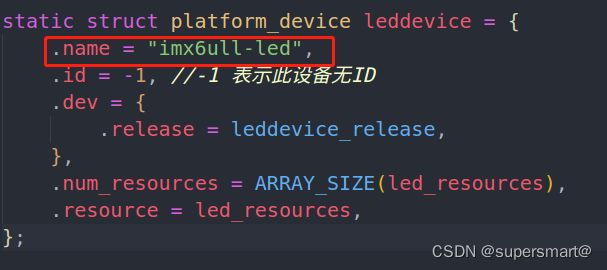
![]()
![]()
同理,查看/sys/bus/platform/drivers/目录,看一下驱动是否存在,我们在 leddriver.c 中设置
led_driver (platform_driver 类型)的 name 字段为“imx6ull-led”,因此会在/sys/bus/platform/drivers/
目录下存在名为“imx6ull-led”这个文件,
![]()
驱动和设备匹配成功以后就可以测试 LED 灯驱动了,输入如下命令打开 LED 灯:
![]()
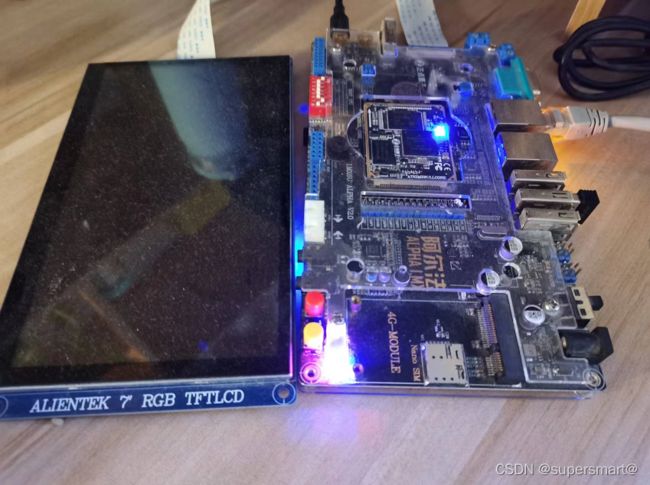
输入如下命令关闭 LED 灯:
![]()
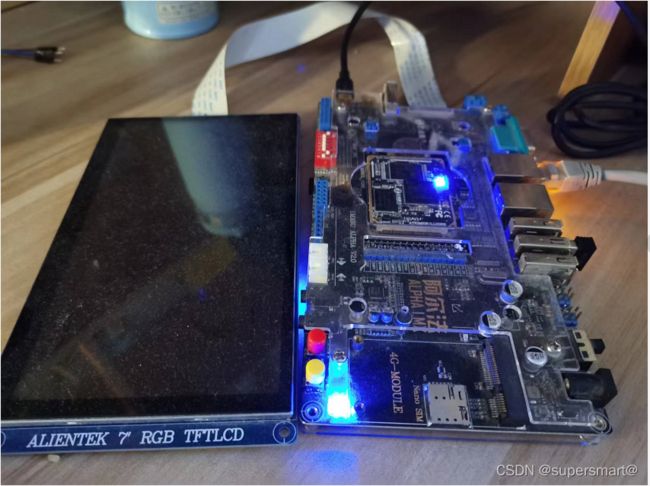
卸载驱动

